
Agamidae is a family of over 550 species of iguanian lizards indigenous to Africa, Asia, Australia, and a few in Southern Europe. Many species are commonly called dragons or dragon lizards.

The Iguanidae is a family of lizards composed of the iguanas, chuckwallas, and their prehistoric relatives, including the widespread green iguana.

The genus Brachylophus consists of four extant iguanid species native to the islands of Fiji and a giant extinct species from Tonga in the South West Pacific. One of the extant species, B. fasciatus, is also present on Tonga, where it has apparently been introduced by humans.
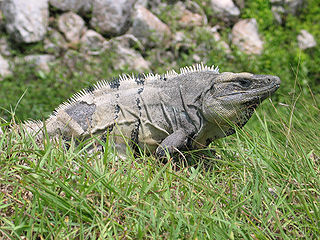
Ctenosaura is a lizard genus commonly known as spinytail iguanas or ctenosaurs. The genus is part of the large lizard family, Iguanidae and is native to Mexico and Central America. The name is derived from two Greek words: κτενός, meaning "comb", and σαύρα, meaning "lizard".
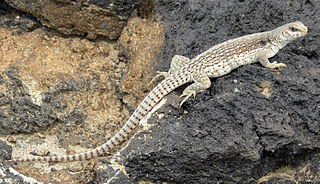
Dipsosaurus is a genus of lizards in the family Iguanidae.
The spiny weapontail is a species of lizard belonging to the monotypic genus Hoplocercus in the family Hoplocercidae. The species is found in the Cerrado and adjacent Cerrado–Amazon mosaics in Brazil and Bolivia.

The zebra-tailed lizard is a species of lizard in the family Phrynosomatidae. The species is native to the Southwestern United States and adjacent northwestern Mexico. There are nine recognized subspecies.
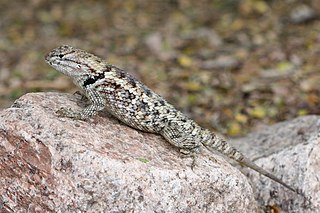
Sceloporus magister, also known as the desert spiny lizard, is a lizard species of the family Phrynosomatidae, native to the Chihuahuan Desert and Sonoran Desert of North America.
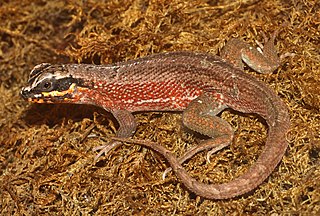
Iguania is an infraorder of squamate reptiles that includes iguanas, chameleons, agamids, and New World lizards like anoles and phrynosomatids. Using morphological features as a guide to evolutionary relationships, the Iguania are believed to form the sister group to the remainder of the Squamata, which comprise nearly 11,000 named species, roughly 2000 of which are iguanians. However, molecular information has placed Iguania well within the Squamata as sister taxa to the Anguimorpha and closely related to snakes. The order has been under debate and revisions after being classified by Charles Lewis Camp in 1923 due to difficulties finding adequate synapomorphic morphological characteristics. Most Iguanias are arboreal but there are several terrestrial groups. They usually have primitive fleshy, non-prehensile tongues, although the tongue is highly modified in chameleons. Today they are scattered occurring in Madagascar, the Fiji and Friendly Islands and Western Hemisphere.
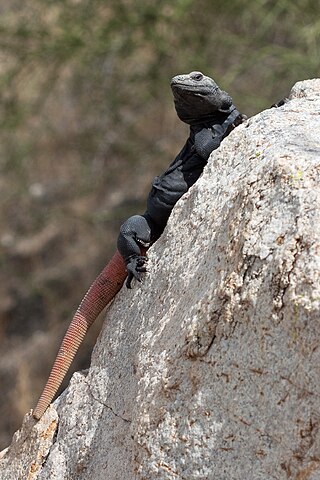
Sauromalus ater, also known as the common chuckwalla, is a species of lizard in the family Iguanidae. It inhabits the Sonoran and Mojave Deserts of the Southwestern United States and northwestern Mexico. Its range extends from eastern California, Utah, and Nevada south to Baja California and Sonora.

Masticophis is a genus of colubrid snakes, commonly referred to as whip snakes or coachwhips, which are endemic to the Americas. They are characterized by having a long, thin body and are not dangerous to humans.

Stenocercus is a genus of South American lizards, commonly called whorltail iguanas, of the family Tropiduridae. This genus has 80 valid described species.
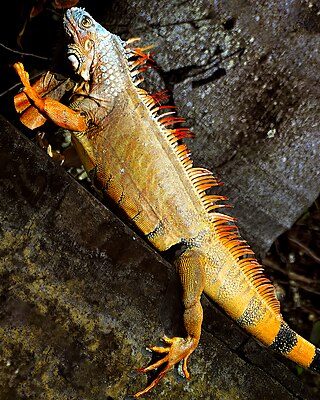
Iguana is a genus of herbivorous lizards that are native to tropical areas of Mexico, Central America, South America, and the Caribbean. The genus was first described in 1768 by Austrian naturalist Josephus Nicolaus Laurenti in his book Specimen Medicum, Exhibens Synopsin Reptilium Emendatam cum Experimentis circa Venena. Three species are placed in the genus: the green iguana, which is widespread throughout its range and a popular pet, the marine iguana and the Lesser Antillean iguana, which is native to the Lesser Antilles. Genetic analysis indicates that the green iguana may comprise a complex of multiple species, some of which have been recently described, but the Reptile Database considers all of these as subspecies of the green iguana.
Lepidosaur herbivory describes herbivorous lepidosaurs. Living non-avian reptiles form a paraphyletic group that consists of over 9,000 species of crocodiles, turtles, and lepidosaurs. The most diverse group, Lepidosauria, is first known from the Middle Triassic fossils, but likely originated in the Permian. Living lepidosaurs, which include snakes, lizards, and rhynchocephalians, occupy a wide range of environments and niches. The lepidosaurs have many similar anatomical morphology like transverse cloaca, distal tongue, superficial teeth attachment, fused pelvic bones etc. Though widely viewed as obligate carnivores, a small number of lepidosaurs are known to consume plant material. For example, there are roughly 3,300 species of living lizards and approximately 3% of them eat at least some plants. Though the exact definition of herbivory varies significantly between scientists, most define herbivorous lepidosaurs as those that consume plants for approximately 70-90% of its diet.
Isla Coronados, is an island in the Gulf of California east of the Baja California Peninsula in Baja California Sur state, Mexico. The island is uninhabited and is part of the Loreto Municipality.
Isla San Luis is an island in the Gulf of California east of the Baja California Peninsula. The island is uninhabited and is part of the San Felipe Municipality.
Enyalius boulengeri, also known commonly as the Brazilian fathead anole, is a species of lizard in the family Leiosauridae. The species is endemic to Brazil.














